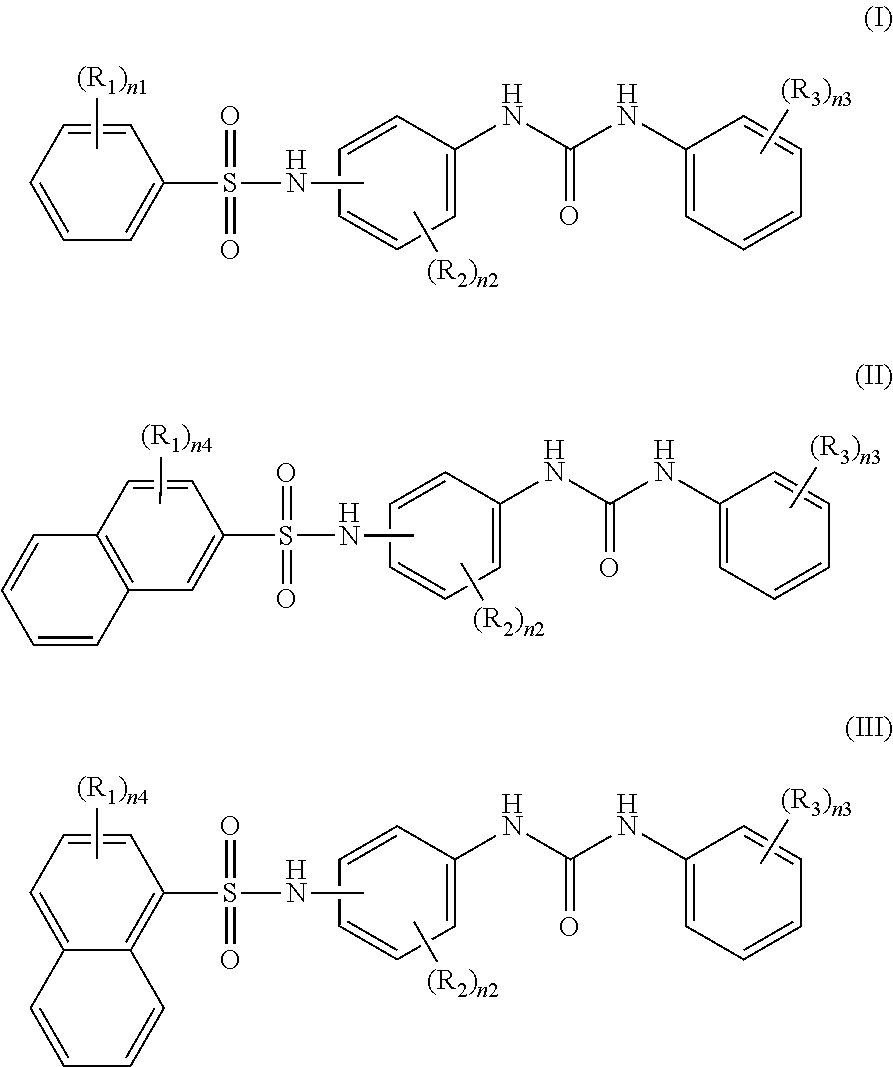Recording material produced using non-phenol compound
a technology of non-phenol compound and recording material, which is applied in the field of thermo- or pressure-sensitive recording material, can solve the problems of not finding sufficiently satisfactory color-developing sensitivity, background and image stability, etc., and not being allowed to be used by some users, and achieves good color-developing performance and plasticizer resistance. , the effect of easy decomposition
- Summary
- Abstract
- Description
- Claims
- Application Information
AI Technical Summary
Benefits of technology
Problems solved by technology
Method used
Image
Examples
example 1
Synthesis of 4-methyl-N-(2-(3-phenylureido)phenyl)benzenesulfonamide (Compound No. 4 in Table 1)
[0120]To 200 ml of ethyl acetate, 10.8 g (0.1 mol) of o-phenylenediamine (manufactured by Tokyo Chemical Industry Co., Ltd., purity 98%) was added, and the resultant was cooled to 5° C. To this solution, 11.9 g (0.1 mol) of phenyl isocyanate (manufactured by Wako Pure Chemical Industries, Ltd., purity 98%) was added dropwise while preventing the temperature from increasing to 10° C. or more. After the completion of the dropwise addition, a reaction was performed at room temperature for 30 minutes. After the completion of the reaction, crystals deposited during the reaction were filtered off to obtain 1-(2-aminophenyl)-3-phenylurea as white crystals (22.1 g, yield 99% with respect to o-phenylenediamine).
[0121]To 200 ml of ethyl acetate, 22.1 g of the 1-(2-aminophenyl)-3-phenylurea and 7.9 g (0.1 mol) of pyridine were added. After adding 19.1 g (0.1 mol) of p-toluenesulfonyl chloride (manu...
example 2
Synthesis of 3-methyl-N-(2-(3-phenylureido)phenyl)benzenesulfonamide (Compound No. 3 in Table 1)
[0123]To 87 ml of ethyl acetate, 1.2 g (5 mmol) of 1-(2-aminophenyl)-3-phenylurea synthesized in the same manner as in Example 1 and 0.9 g (9 mmol) of triethylamine were added. To this solution, 1.7 g (9 mmol) of m-toluenesulfonyl chloride (manufactured by Wako Pure Chemical Industries, Ltd., purity 97%) was added dropwise at room temperature. After refluxing for 4 hours, the reaction solution was washed with 2N hydrochloric acid. After removing an aqueous layer, the solvent was distilled off under reduced pressure. To the residue, 20 ml of ethanol was added to deposit crystals. The crystals were filtered off and vacuum dried to obtain the title compound as white crystals (2.42 g, yield 73% with respect to o-phenylenediamine). Melting point: 161-164° C.
[0124]1H-NMR (d6-DMSO): δ 2.33 (3H), 6.48 (1H), 6.79 (1H), 6.98 (1H), 7.17 (1H), 7.30 (2H), 7.43-7.49 (5H), 7.54 (1H), 8.00-8.02 (1H), 8....
example 3
Synthesis of 2-methyl-N-(2-(3-phenylureido)phenyl)benzenesulfonamide (Compound No. 2 in Table 1)
[0125]To 170 ml of ethyl acetate, 3.9 g (15 mmol) of 1-(2-aminophenyl)-3-phenylurea synthesized in the same manner as in Example 1 and 1.8 g (18 mmol) of triethylamine were added. To this solution, 3.3 g (8.5 mmol) of o-toluenesulfonyl chloride (manufactured by Wako Pure Chemical Industries, Ltd., purity 95%) was added dropwise at room temperature. After refluxing for 4 hours, the reaction solution was washed with 2N hydrochloric acid. After removing an aqueous layer, the solvent was distilled off under reduced pressure, and to the residue, 20 ml of ethanol was added to deposit crystals. The crystals were filtered off and vacuum dried to obtain the title compound as white crystals (2.8 g, yield 43%). Melting point: 147-150° C.
[0126]1H-NMR (d5-DMSO): δ 2.52 (3H), 6.38 (1H), 6.75 (1H), 6.99 (1H), 7.16 (1H), 7.29-7.32 (3H), 7.40-7.42 (1H), 7.48-7.53 (3H), 7.65 (1H), 7.98 (1H), 8.34 (1H), 9....
PUM
 Login to View More
Login to View More Abstract
Description
Claims
Application Information
 Login to View More
Login to View More - R&D
- Intellectual Property
- Life Sciences
- Materials
- Tech Scout
- Unparalleled Data Quality
- Higher Quality Content
- 60% Fewer Hallucinations
Browse by: Latest US Patents, China's latest patents, Technical Efficacy Thesaurus, Application Domain, Technology Topic, Popular Technical Reports.
© 2025 PatSnap. All rights reserved.Legal|Privacy policy|Modern Slavery Act Transparency Statement|Sitemap|About US| Contact US: help@patsnap.com



